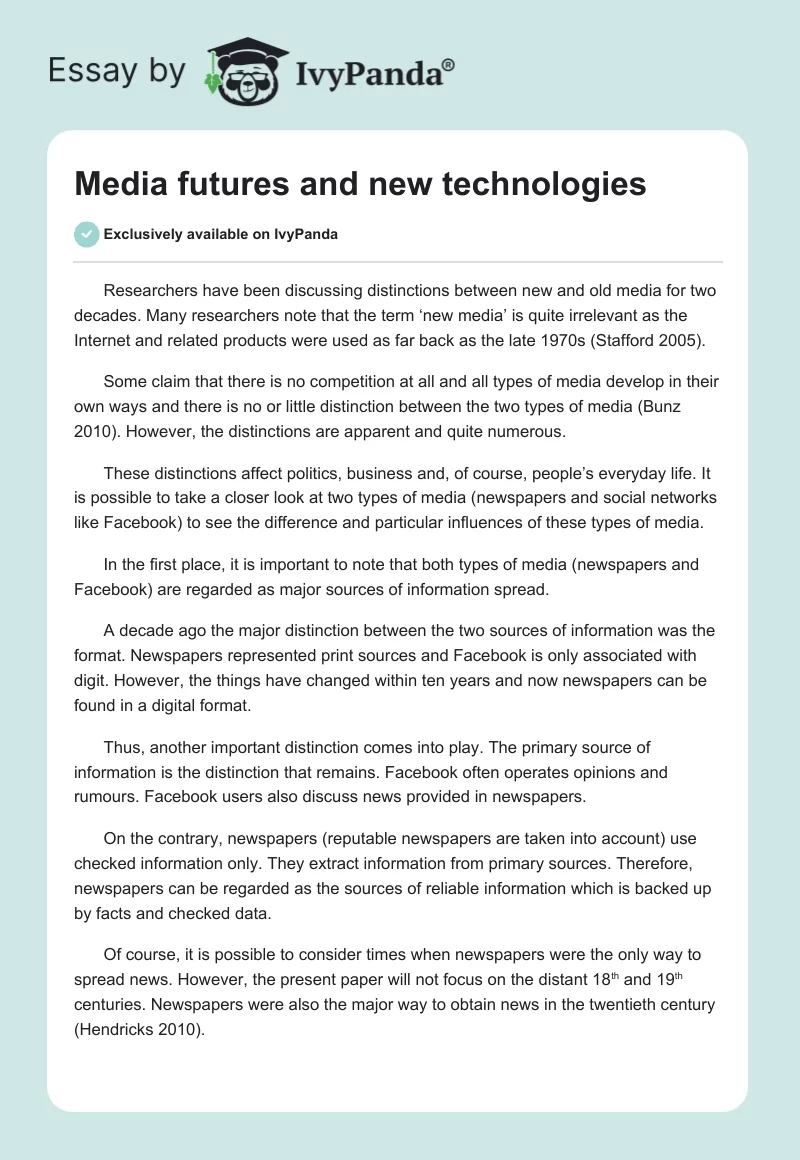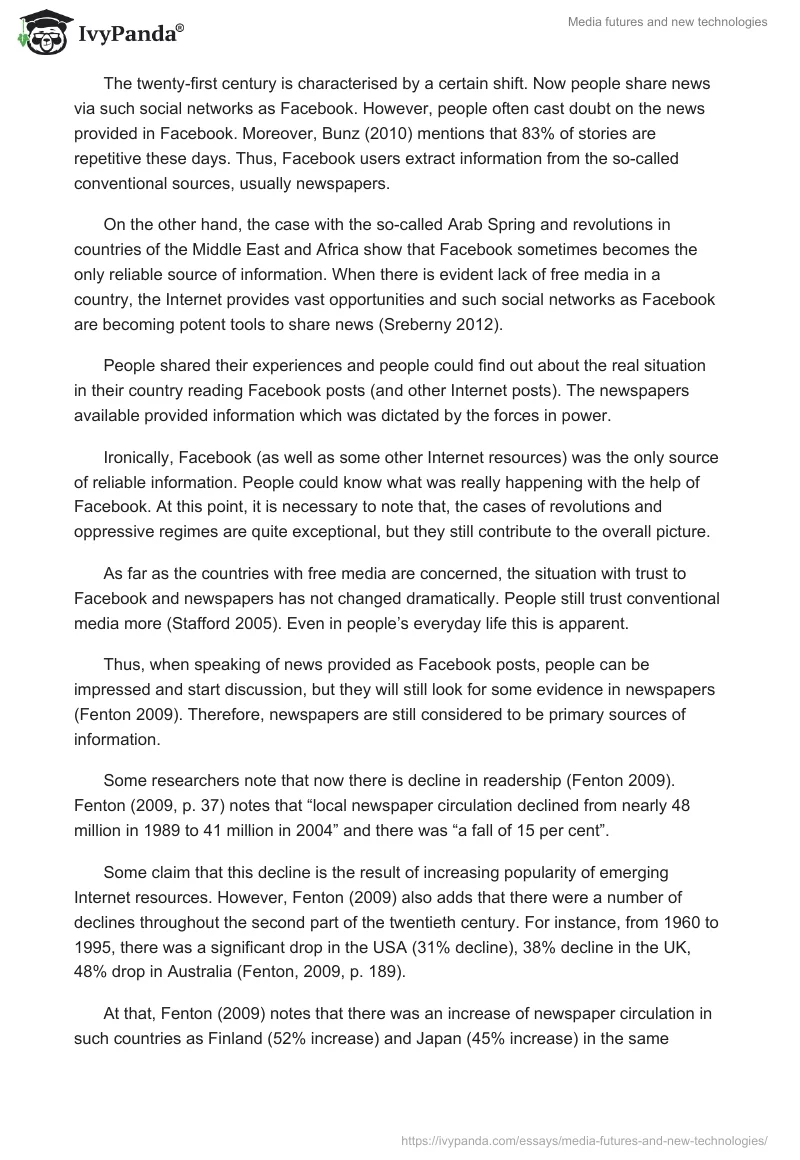Researchers have been discussing distinctions between new and old media for two decades. Many researchers note that the term ‘new media’ is quite irrelevant as the Internet and related products were used as far back as the late 1970s (Stafford 2005).
Some claim that there is no competition at all and all types of media develop in their own ways and there is no or little distinction between the two types of media (Bunz 2010). However, the distinctions are apparent and quite numerous.
These distinctions affect politics, business and, of course, people’s everyday life. It is possible to take a closer look at two types of media (newspapers and social networks like Facebook) to see the difference and particular influences of these types of media.
In the first place, it is important to note that both types of media (newspapers and Facebook) are regarded as major sources of information spread.
A decade ago the major distinction between the two sources of information was the format. Newspapers represented print sources and Facebook is only associated with digit. However, the things have changed within ten years and now newspapers can be found in a digital format.
Thus, another important distinction comes into play. The primary source of information is the distinction that remains. Facebook often operates opinions and rumours. Facebook users also discuss news provided in newspapers.
On the contrary, newspapers (reputable newspapers are taken into account) use checked information only. They extract information from primary sources. Therefore, newspapers can be regarded as the sources of reliable information which is backed up by facts and checked data.
Of course, it is possible to consider times when newspapers were the only way to spread news. However, the present paper will not focus on the distant 18th and 19th centuries. Newspapers were also the major way to obtain news in the twentieth century (Hendricks 2010).
The twenty-first century is characterised by a certain shift. Now people share news via such social networks as Facebook. However, people often cast doubt on the news provided in Facebook. Moreover, Bunz (2010) mentions that 83% of stories are repetitive these days. Thus, Facebook users extract information from the so-called conventional sources, usually newspapers.
On the other hand, the case with the so-called Arab Spring and revolutions in countries of the Middle East and Africa show that Facebook sometimes becomes the only reliable source of information. When there is evident lack of free media in a country, the Internet provides vast opportunities and such social networks as Facebook are becoming potent tools to share news (Sreberny 2012).
People shared their experiences and people could find out about the real situation in their country reading Facebook posts (and other Internet posts). The newspapers available provided information which was dictated by the forces in power.
Ironically, Facebook (as well as some other Internet resources) was the only source of reliable information. People could know what was really happening with the help of Facebook. At this point, it is necessary to note that, the cases of revolutions and oppressive regimes are quite exceptional, but they still contribute to the overall picture.
As far as the countries with free media are concerned, the situation with trust to Facebook and newspapers has not changed dramatically. People still trust conventional media more (Stafford 2005). Even in people’s everyday life this is apparent.
Thus, when speaking of news provided as Facebook posts, people can be impressed and start discussion, but they will still look for some evidence in newspapers (Fenton 2009). Therefore, newspapers are still considered to be primary sources of information.
Some researchers note that now there is decline in readership (Fenton 2009). Fenton (2009, p. 37) notes that “local newspaper circulation declined from nearly 48 million in 1989 to 41 million in 2004” and there was “a fall of 15 per cent”.
Some claim that this decline is the result of increasing popularity of emerging Internet resources. However, Fenton (2009) also adds that there were a number of declines throughout the second part of the twentieth century. For instance, from 1960 to 1995, there was a significant drop in the USA (31% decline), 38% decline in the UK, 48% drop in Australia (Fenton, 2009, p. 189).
At that, Fenton (2009) notes that there was an increase of newspaper circulation in such countries as Finland (52% increase) and Japan (45% increase) in the same period. Obviously, decline or increase of newspaper circulation has little to do with development of new technology.
Nevertheless, newspaper owners have been trying to address the problem of decline and came to quite a similar decision. Now newspapers have acquired digital format to become more up-to-date. Researchers state that now the two types of media merge (Rogers 2005).
French (2011, p. 17) notes that newspapers have “toyed with experiments including advertising price increases, paid subscriptions to their websites, and even developing iPad-only magazines”. Pfeiffer and Zinnbauer (2010) also note that major newspapers are now available online, which makes them available 24 hours a day.
Now they can provide news 24 hours a day, which makes these sources almost equal to Facebook. Newspapers are almost equal in terms of the load of information as they still have comparatively scarce resources.
Facebook posts can be created by any user of Facebook who witnessed something (or decided to share his/her opinion). At the same time, qualified reporters (the number of these professionals is almost insignificant compared to the number of Facebook users) generate news which appear in newspapers.
It is necessary to note that these differences affect politics, business and people’s everyday life. For instance, politics used to rely on newspapers and television in the twentieth century. The politics of the twenty-first century resort to new media. Thus, US President Obama resorted to Facebook and YouTube during his election campaign, which proved to be successful.
As for business, in the twentieth century, business sent their releases to newspapers to spread news about their companies (Rogers 2005). Now there is no need in such precision as any company has its own website where news concerning the company can be posted.
Companies also resort to Facebook quite often. Nonetheless, companies still rely on conventional resources especially when it is important to cover a large audience and spread some important news.
The differences between the two sources are quite evident in the field of advertisement. Thus, Facebook as any other Internet resource is very attractive for advertisers due to quite vast opportunities. Pop-ups and a variety of other types of advertisement can be available online.
However, the policy of this resource is to have small amount of advertisement. At the same time, print newspapers do not have so many opportunities due to quite restricted space.
Nonetheless, online newspapers are not inferior to Facebook and any other online resource. More so, newspapers do not have such restrictions as Facebook, which makes the former more attractive for advertisers.
As has been mentioned above, the distinctions between Facebook and newspapers can be traced in people’s everyday life. Though there is certain decline of readership, people still read newspapers (print as well as digital). Of course, young people tend to spend more time socialising in Facebook. Older people tend to read newspapers more, whereas young people read Facebook posts.
Notably, one of the major distinctions between the two sources, i.e. the primary source of news, has led to certain change in people’s life and their aspirations. Thus, to become a newsmaker, one should have become a famous person, a person who stood out against the crowd.
To provide news to public, people also had to study and become professional journalists. However, now Facebook provides a lot of opportunities to all people who have access to the Internet. Thus, Facebook users reveal their opinions or share their routine and are already regarded as newsmakers.
As for professional journalists, Facebook does not need such professionals. Any Facebook user can write about an event which took place in his/her community. Again, a Facebook user can provide his/her opinion on some news, events or even opinion provided by another Facebook user. All these people feel they are journalists who contribute to spread of important or meaningful information.
On balance, it is possible to note that newspapers and Facebook are regarded as some of the major resources of information spread. The two major distinctions between the two sources are the format and the primary sources used.
Thus, newspapers (both print and digit) are still regarded as reputable sources which provide reliable information whereas Facebook is not seen as a reliable source of information and Facebook users often refer to newspapers.
However, it is important to note that in some countries under specific circumstances Facebook have been the only source of reliable information.
All these peculiarities of the two sources have affected people lives in many ways. Of course, one of the most meaningful changes is that people are now becoming active agents in the process of information sharing which is important in the contemporary globalized world.
Reference List
Bunz, M 2010, ‘Old media or new media – who breaks the news today?‘, Guardian. Web.
Fenton, N 2009, New media, old news: journalism and democracy in the digital age, SAGE Publications Ltd., London.
French, K 2011, ‘Emerging convergence’, The HUB. Web.
Hendricks, JA 2010, The twenty-first-century media industry: economic and managerial implications in the age of new media, Lexington Books, Plymouth.
Pfeiffer, M & Zinnbauer, M 2010, ‘Can old media enhance new media? How traditional advertising pays off for an online social network’, Journal of Advertising Research 50.1, pp. 42-50.
Rogers, R 2005, ‘New media effects: do formats organize networks?’, Complexity 10.4, pp. 22-34.
Sreberny, A 2012, ‘ New media and the Middle East: thinking allowed’, II Journal. Web.
Stafford, MR 2005, Advertising, promotion, and new media, M.E. Sharpe, New York.


